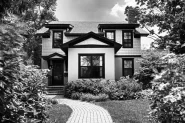A St. Paul Treasure

Since it began in 1972, the Summit Hill House Tour has been a hit for Twin Cities’ folks and those far beyond the metro area. In fact, it is one of the most popular historic house tours in the nation. This biennial event (every even year) is the major fundraiser for the Summit Hill Association (SHA) that supports every program and event sponsored by SHA. The programs and events include — communications (newsletter and website), promotion and recruitment of citizen volunteers, crime prevention block and building clubs organizing, neighborhood review of zoning applications, annual clean-up drives, park and Grand Avenue “greening” beautification efforts, recycling, traffic calming and much more!
The houses featured in this year’s tour look spectacular! In fact, the whole area of Summit Hill is brimming with Arts and Crafts design and aesthetic. The exterior ‘teaser’ photos on their website definitely leave us daydreaming about the interiors of each home. A little history on the area: the first residential development of the Summit Hill area took place in the 1850’s and 1860’s when many wealthy and prominent St. Paul families moved from the central riverfront area. With the exodus came James Burbank, who in 1862 built Summit Avenue’s first mansion at 432 Summit. Burbank made his fortune in the riverboat and stagecoach business, and caused a sensation by incorporating such amazingly modern features as steam heating, hot and cold water, and gas lighting in his new home.
In the 1880’s and 1890’s the Crocus Hill and Grand Hill neighborhoods became fashionable locations for the wealthy families of St. Paul. Summit Avenue was known as “Rag Row” in the 1890’s because many of the leaders of St. Paul’s growing wholesale clothing industry lived there. Early railroad and lumber barons also lived on Summit Avenue and in the adjacent areas, with families such as the Burbanks and Weyerhhaeusers leading the social life of the Hill.
By the early 1900’s, encouraged by the trolley lines that connected the area with the downtown business district, the first wave of middle class professionals began to populate the rest of Summit Hill. They settled mainly in the southwestern portion of the district, constructing mostly spacious, wood frame houses. Many rowhouses and elegant apartment buildings, built mostly of brick, sprang up at the same time. Many of these multi-unit buildings have been converted into charming condominiums. Small business owners, skilled laborers, and clerks settled along Grand and Lincoln Avenues as the Grand Avenue line provided inexpensive and convenient transportation. The wealthy continued to live on Summit Avenue, thus avoiding the noise and smell of the street cars.
Then, during the 1920’s, as St. Paul grew to the west, the street car lines along St. Clair and Grand Avenues prompted developers to replace many of the single-family residences with apartment buildings. As Grand Avenue’s commercial development continued to grow, a St. Paul zoning ordinance, which went into effect in 1922, made the land along the street car lines single-family zones, just as Summit had been since 1894. The late 1920’s saw the last major residential developments occurring within the Summit Hill area west of Lexington and on a few scattered bluff sites. Since very few buildings have been constructed since the 1920’s, the Summit Hill neighborhood looked then very much as it does today.
You definitely don’t want to miss this wonderful house tour if you’re in the area. For more information and to purchase your tickets please visit www.summithillhousetour.com

